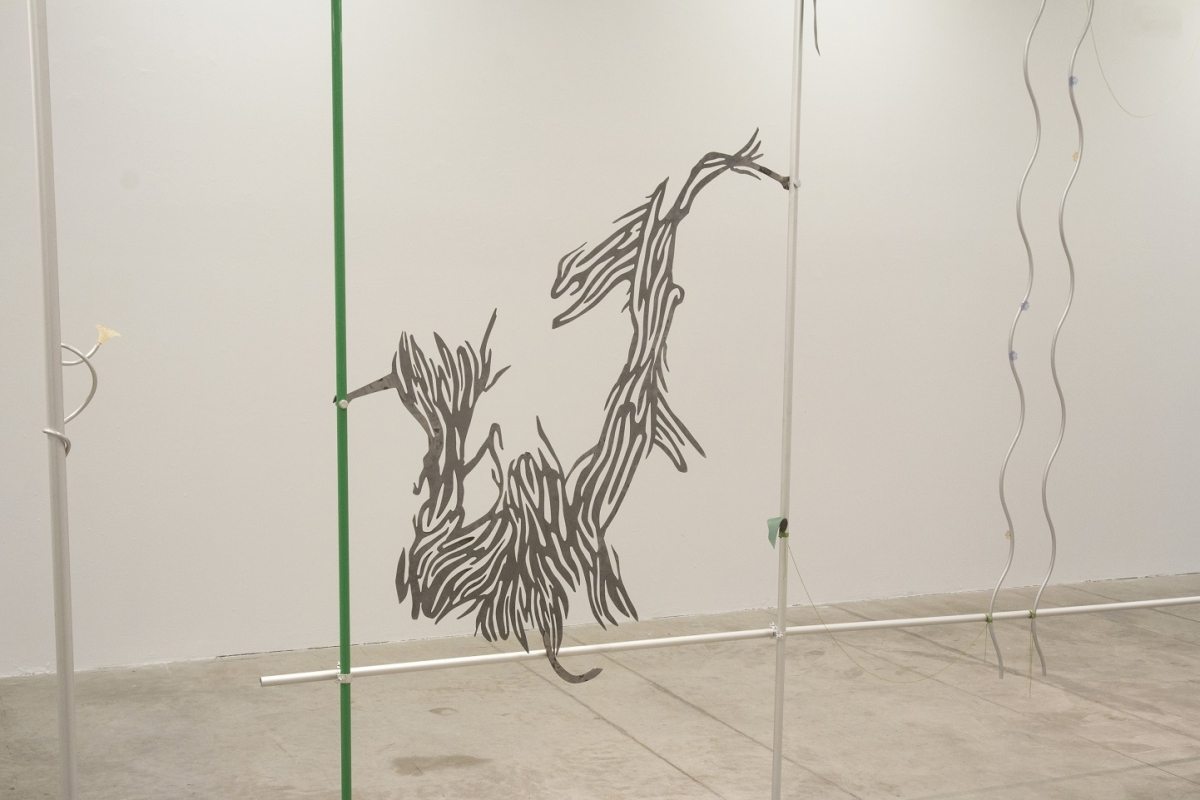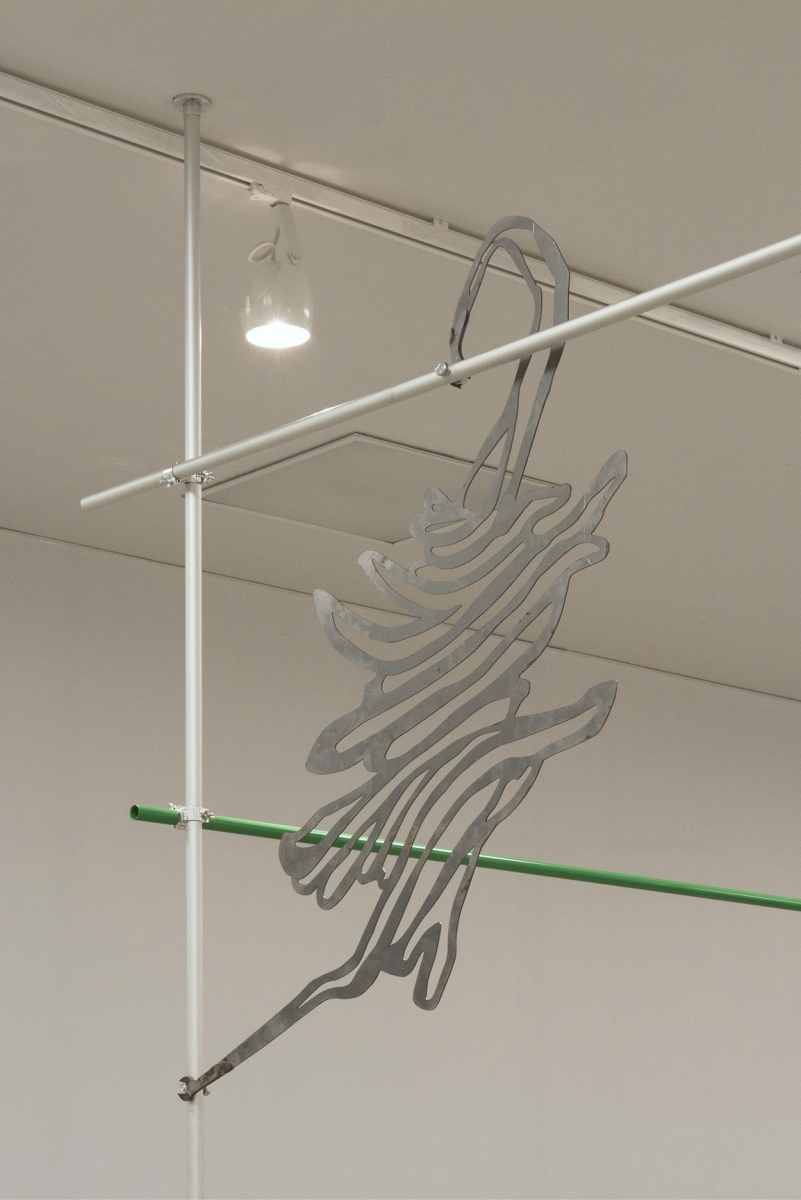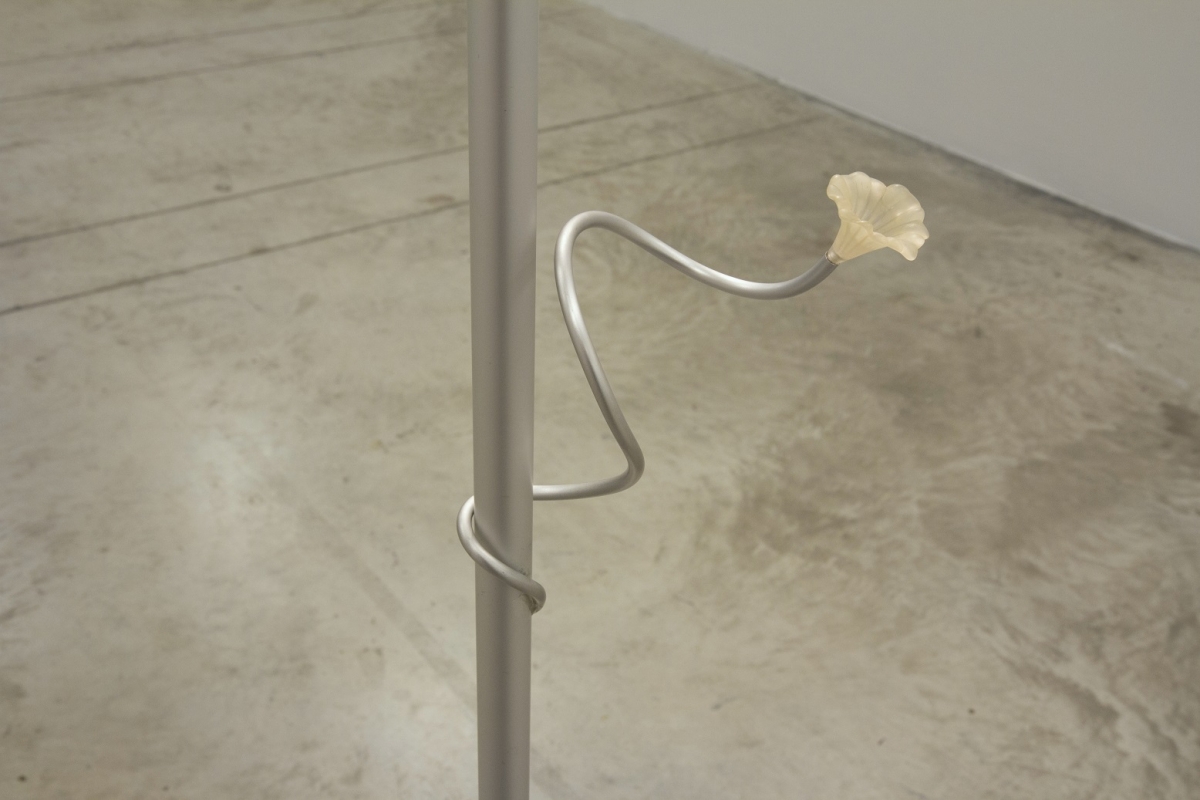
“What can be shown, cannot be said.”
(Tractatus Logico-Philosophicus, 4.1212)
Halfway between the Contemporary Landscape exhibition at the Cēsis Art Festival, and Vienna’s ambitious claim to have hosted the first large-scale exhibition representing painting in the information age (the Painting 2.0 exhibition which took over four storeys of the mumok museum in Vienna), I turned into the small Intro Hall of the Riga Art Space to look at a work of art by three young artists: Darja Meļņikova, Kaspars Groševs and Indriķis Ģelzis. In the middle of the room – the construction-installation; at the entrance – a small text in Latvian. (My last sentence intentionally lacks a verb).
I will begin with two contradictory statements. The first is that I am both suited and unsuited to write about this work of art. The second is that the short, untitled, aforementioned statement about the work of art is both compatible and incompatible with the exhibition. (A third statement – regarding the name of the exhibition, San Serriffe, which some viewers will read as sans serif – will remain unexpressed.) The first statement is easier to explain, to wit, I was once the reviewer for Groševs’ and Meļņikova’s (or, simply, Daša’s) master’s thesis projects at the Art Academy of Latvia. The artists, who had organised two solo exhibitions at kim? Gallery, did not receive the highest of marks due to the academy’s tendency towards conservatism. Back then, in 2011, I spoke with both artists in detail about the ideas and suggestions their artwork was based on, as well as the circumstances of their creation and so on. Now, having run into Daša in Cēsis (we recognised each other’s voices in a darkened room where a work of video art was being shown), I learned that the idea of doing an exhibition together had come from Ģelzis, and that instead of doing three separate exhibitions, they had decided to make one work of art together. I said that the installation looked “Daša-like”, to which it’s possible that she smiled, though I couldn’t see if she did in the dark, of course. I didn’t ask her much more because I wanted to experience the installation myself (or rather, I wanted to discover for myself the semantic impression a piece of artwork could provide for its understanding), despite the video we were watching lasting more than an hour, I imagined.
So much for “suited” and “unsuited”… because I like conceptual certainty, such as can be found, for example, in Mel Bochner’s statement “LANGUAGE IS NOT TRANSPARENT” written in white chalk on a black background almost half a century ago (I hope the reader will smile even if he or she is not familiar with this work). Continuing this explanation of unsuitability, I shall proceed with my second statement, which will also constitute the “substance” of my review.
The text, which I instantly judged to have been written by Groševs (only now, two weeks later, do I notice the initials K. G. at the bottom of the sheet of paper), is made up of literary refined references; one immediately feels an aspiration towards seriousness and being a man of letters, which nowadays is a dying breed of human being. Groševs quotes a witty remark by Adorno about the semicolon (as I discovered from a short article titled ‘Punctuation Marks’ in Shierry Weber Nicholsen’s translation), which brought to mind a comment by another, this time Russian, translator (with an exclamation mark!) regarding a sentence by Gertrude Stein in which she, an author who even by the standards of the little-punctuated English language practically used no punctuation at all, had placed a semicolon. (Knowing Stein’s texts, the story is quite believable (even though I did not find the specific sentence when paging through the translations of her work that I have at home, and there was no point in searching through her original works)…. [And another note to readers unfamiliar with the Latvian language: our punctuation rules are as difficult as our pronunciation. Longer sentences contain so many commas and other punctuation marks that their frequency corresponds to one philosopher’s – who wrote in German, however – desire to use even more punctuation marks than the grammar of his native language demanded in order that readers would read his works more slowly]).
So far, this review has indicated both the compatibility and incompatibility of the exhibition by these three artists to the short text accompanying it. Compatibility would be characterised by a positive answer to the question of whether the installation allows the viewer to “read” and “create” specific chains of associations and references such as the ones which the fragment of text aroused in me. A negative answer would affirm that they can only be “read” or “created” by those who are familiar with this sort of language game (my last reference to Wittgenstein – I have, after all, just returned from Vienna!). (Maybe I should say a word or two about the installation itself, although that would not help much for understanding either the work of art or my review. I’ll therefore leave the whole passage in parentheses: scaffolding made of thin metal pipes forms a rectangular parallelepiped in which viewers can enter; all sorts of small trinkets and details are hung from, or attached to, the scaffolding, such as small, wavy metal pipes, a rag, a piece of fabric, some scribbled pictures, webs of metal lines that resemble something from Groševs’ master’s thesis project, flower-shaped light bulbs and also a green, Dan Flavin-like daylight bulb… the construction is less dense and more transparent than this description might lead one to think.)
The line of incompatibility could be continued by that which should associate with the name of Adorno (some names are with a too long, comet-like tail…) – the truth content of a work of art (Wahrheitsgehalt), the role of non-art moments in the meaning of a work of art, and so on. Of course, a certain role in an installation is also played by something outside the actual construction (this is not a work to be perceived in the aesthetics of formalism, even though a casual passerby could perceive it as such), except that this work by the three artists – and I struggle to find a word that is uncharacteristic of my idiolect –is too “trendy”. For example, at the last Venice Biennale, the “Daša-like” work in the curator’s exhibition was that is the last item on this list: a glass of anger, an installation (whose title is characteristically rich in allusions) by the Georgian-born artist Thea Djordjadze, who studied in Amsterdam and Düsseldorf.
One could say that there is currently a trend in the language of art away from direct statements towards design-like form, aestheticised allegories or suggestions, and to do so in a non-aggressive way; in the best examples, it is done with irony. Non-art moments are important in the meaning of such works of art, but, considering their non-obligatory character, the works themselves supposedly claim only to toy with the substantive marginalia, which, on the other hand, having become universally accepted, links them with the concepts of fashion and fashionability.
‘Fashion’ is a term with many levels of meaning, but I cannot forget a thought by Paul Valéry (as an aside, it is also quoted in Walter Benjamin’s voluminous The Arcades Project) from his 1930s article about landscape, ‘Autour de Corot’, or, more precisely, Jean-Baptiste-Camille Corot. Valéry writes: “Finally, that switching – at high frequency – of the tastes of a given public, which is called Fashion, replaced with its essential changeableness the old habit of slowly forming styles, schools and reputations. To say that Fashion took over the destinies of the fine arts is as much as to say that commercial interests were creeping in.” Of course, his statement is about landscape painting and was expressed more than 80 years ago. Time has passed, fashions (in art) have changed, but the issue addressed by Valéry remains – to what extent does art fashion mean yielding to commercial interests and consumerism, and is it possible to overcome this, for example, with irony?
Unfortunately, I cannot provide an answer to this; I can only repeat Benjamin’s paradoxical thought – he not only writes out fragments of Valéry’s work in his manuscript-collage (B8, 2), but in another place (B1, 8) he notes: “For the philosopher, the most interesting thing about fashion is its extraordinary anticipations.” What are these anticipations?
Only in Benjamin’s time did the fashion for Proust develop; today, the musical phrase from Vinteuil’s sonata, which so moved Swann, is widely known in its literary form. However, possibly less known is the fact that, in a letter to Jacques de Lacretelle, Proust indicated its main prototype, namely Camille Saint-Saëns’ (a musician whom Proust did not like!) Sonata for Violin and Piano (the other influences upon which the literary construction is based are less important). Right after the exhibition, and also now as I write, I feel like asking whether there is also something bitterer, harsher and less lovable behind the semicolon’s “gamey taste”, which Groševs’ text invites us to stop at. That little phrase by Vinteuil as performed by the Riga trio – we can describe the artists thus, in this situation, because in this installation the individual artists have melded together like in a fine performance of chamber music – does not provide an answer. Does it show it instead?
P.S. It’s not hard for me to imagine that Groševs, having read this review, will say, “It’s written – I’m writing with a pen right now – in the Times New Roman font.” And a moment later, when I sit down at the computer, he will have been right…

















Photography: Indriķis Ģelzis






























